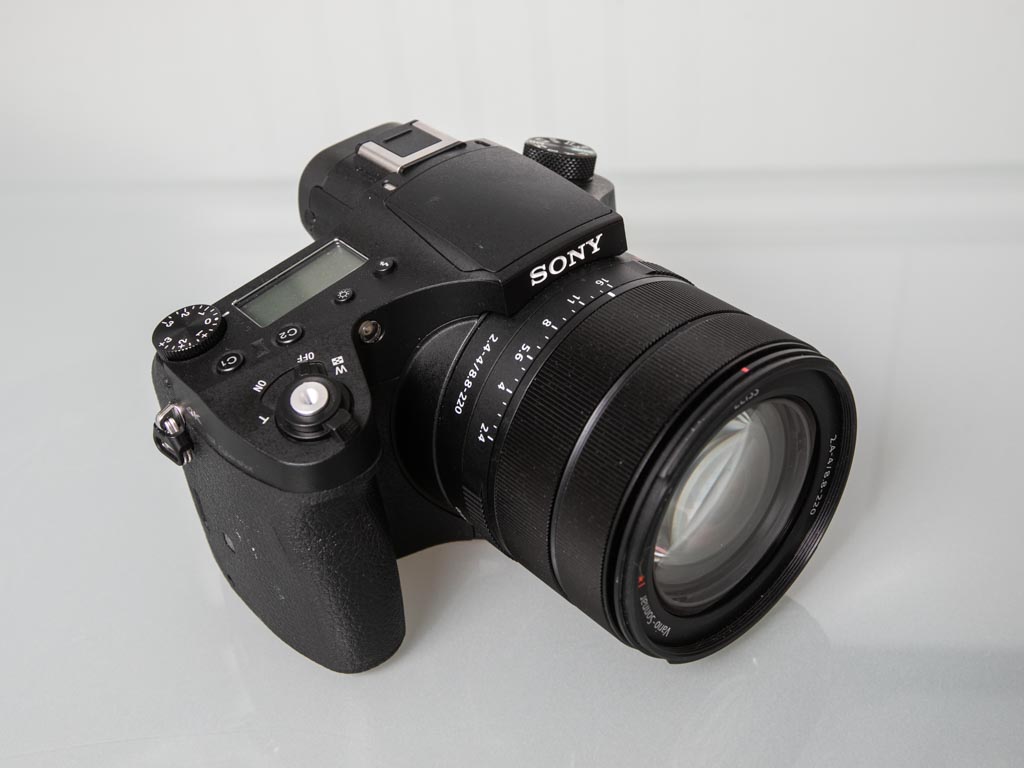
The Sony RX10 IV is a compact camera with one of the most impressive zoom lenses on the market. It has an incredibly fast autofocus speed at just 0.03 seconds and on top of that it can shoot up to 25 frames per second.
And that’s not all.
It has image stabilization, shoots 4K video and has Wi-Fi remote control and image sharing. This is a very serious compact camera.
Unboxing the Sony RX10 IV
The first thing that struck me when I unboxed the RX10 IV was the size and weight of the lens. Although it makes the unit overall a bit forward-heavy, it immediately gave me confidence that this was a camera for the serious enthusiast. The lens is a ZEISS Vario-Sonnar® T* Lens, with a maximum aperture range of f/2.4-f/4. Those wider apertures mean improved low-light performance and the ability to achieve the bokeh effect that blurs your backgrounds and makes your subject pop.
The T* designation refers to a lens coating which reduces distortion effects and gives your shots better clarity. I’ve reviewed a couple of high-end Sony lenses in the past with the T* coating and I’ve been really impressed with the results.
Review: Sony Sonnar T* FE 55mm f/1.8 ZA – Release Your Inner Artist
Review: Should you upgrade to the high-quality Sony Sonnar T* FE 35mm f/2.8 ZA camera lens
The RX10 feels like a DSLR Camera
Ergonomically, the RX10 IV feels quite like a DSLR, with a nice solid handgrip. The lens itself is fixed, and not interchangeable. There are two options for zooming; you can either use the control ring on the barrel of the lens, or you can use the control positioned at the shutter button.

You have five focusing options and these are available to select either through the menu options or via the dedicated knob on the front of the camera. I really like the DMF option which allows you to autofocus by half pressing the shutter button and then override that using the focus ring located on the lens barrel in front of the zoom ring.
Handy control rings on the lens barrel
I will admit that I found myself getting confused between the zoom ring and the focus ring as they feel basically the same. I’m sure with a bit more practice I would soon overcome this issue, but nonetheless it would’ve been a nice design touch if the two rings were immediately differentiable by touch.
Another feature of the lens barrel that I really appreciated was the aperture selection ring. I like to shoot in manual mode and that is mostly because I want to choose my own aperture. I love the fact that you can choose to de-click the aperture selection ring so that it rotates smoothly. This is a great feature for shooting video as it eliminates the clicking sound as you move between apertures.

Camera purists will love the RX10 IV
In an effort to please photography purists, Sony has included an exposure compensation dial that you can control with your thumb. This allows you to fine-tune the exposure setting chosen by the camera when you know that the camera is going to underexpose or overexpose your shot. There is also a small LCD screen on the top of the camera, much like those that you find on full-fledged DSLRs. It gives you a quick view of all the important settings, like aperture, shutter speed, and drive mode, plus the number of shots remaining and the battery level.
The RX10 is customizable
There are also two buttons on top of camera, and one on the back, that you can customize to suit your needs. I really like the level of customization that is available with the RX10 IV because it gives me the ability to set the camera up the way that works best for my particular shooting style.
A great camera to shoot sports
The two features that jumped out at me when I picked up the RX10 IV were the huge zoom and the frame rate. It can shoot 25 frames per second, which is actually enough frames to create video! According to the specs it can shoot up to 249 frames in a single burst. These are very impressive numbers, and I knew that the best place to test this camera out was at the baseball diamond.
How to avoid camera shake
My big concern was that using that very long zoom would lead to camera shake, which is something I need to be very aware of when I shoot my with own telephoto lens on my DSLR. The rule of thumb is that you need to shoot at a shutter speed that is two times the focal length. So for example, if your focal length is 200mm, you need to shoot at 1/400sec. You can read the focal length right off the barrel on the RX10 IV as it zooms.

When my son went up to bat, I positioned myself way back in the outfield so that I was safely removed from the action. And yet, with that long lens, I had no trouble zooming right in on the strike zone.

I was impressed to notice how effective the SteadyShot feature was at minimizing camera shake caused by my hand movements, before I even took the shot. Right there on the LCD screen I could see the stabilization happening. And when I downloaded the shots to my computer I was even more impressed as every single one of them was sharp and without any shake-induced blur.
Rapid fire shots in burst mode
The rapid fire of the continuous burst mode was a joy to behold. The sound of the shutter popping 24 times a second really is something else. I love the review method the RX10 IV uses where it groups images shot in a single burst together, which allows you to review the set and decide whether to keep or delete them all. The only downside of burst mode was that the camera would limit operations while it wrote all those images to the memory card. Be sure to check out the video to see the results of my continuous shooting tests.
Shooting portraits with the RX10 IV
Although this is clearly a great camera for shooting sports, and definitely a good camera for nature and wildlife, I wasn’t sure it would be a good option for portraits. But some of the candid shots I was able to get of my son were really nice. I was even able to create the bokeh effect with those nicely blurred out backgrounds.


The RX10 IV is an excellent camera
All in all, I have to say that I really enjoyed shooting with the Sony RX10 IV. The image quality was excellent, thanks in large part to that Zeiss lens. The zoom and burst mode delivered spectacularly and I was able to quickly share my photos with other parents at baseball thanks to the Wi-Fi feature. I don’t think that professional photographers would jump on a camera like this simply because it has a small sensor (since it would mean that the low-light performance isn’t great). Also, you’re limited in the size of the prints you can make because the files are a lot smaller than you would get from an APS-C or a full-frame sensor.
Bottom line, this is an excellent camera for parents with kids in sports and those who like to shoot nature and wildlife.



